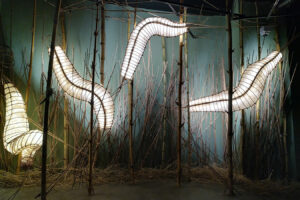THE SOUND of gongs and the smell of smoke herald the beginning of ritual sacrifices in the Cordillera region. When the chicken is killed, its blood spills onto the ground, the culmination of paying tribute to the spirits and a joyous celebration of the earth.
This very scene is where the latest exhibition at the Ateneo Art Gallery, Gongs. Smoke. Blood. Earth., takes its name. It is a show that serves as an exploration or survey of Baguio art.
Aside from presenting works by the current zeitgeist of Baguio-based artists, it delves into their history and cultural context, dating back to the founding of the Baguio Arts Guild in 1986.
The exhibit is an extension of the book Tiw-tiwong: an Uncyclopedia to Life, Living, and Art, in Baguio, the Cordilleras and Beyond, published by Baguio Kunst Publishing in 2023.
For one of its main proponents, artist Kawayan de Guia, the book’s aim is to chart the relationship between indigenous communities and the artists, whether schooled or unschooled. The exhibition brings these connections to life at the Ateneo Art Gallery.
“There has never actually been a Baguio show in Manila, in a museum, ever. There have been a lot of exhibits of certain individuals in galleries, but there hasn’t been anything that sort of encapsulates a holistic view of Baguio,” he told the press at a preview on April 5.
“I don’t know if it’s a Manila-centric thing. Well, everyone wants to go to Baguio, so why bring the works down? There was no reason to do that because everyone just comes up,” he said.
A highlight in this exhibition of Baguio art is a recreation of Santiago Bose’s installation Bamboo Radar, which greets visitors at the lawn of Ateneo’s Arete building, which houses the gallery.
Mr. De Guia’s father, National Artist Kidlat Tahimik, also contributed an “unconscious curation” of wood carvings, bulul figures, and sculptures that he had picked up over the years.
“Back in ’86, with the guild, our appreciation for precolonial art had begun to seep in among the younger artists. I think now, we have people who are grounded in Cordilleran art. There was really a transition back then. It used to be exotic for some of us to play with our ancestral art, but I think it’s become full-blooded and grounded, coming out naturally with our expression,” he said.
Ateneo Art Gallery director Victoria “Boots” Herrera added that the exhibit tries to understand “the essentials of what Baguio art is, its history, the works, and where it’s heading.” The exhibit includes works of founding members of the guild: National Artist Benedicto “BenCab” Cabrera, photographer Tommy Hafalla, Rene Aquitania, Willy Magtibay, and Perry Mamaril.
“We have a lot of work from artists that have passed, but have really defined the ‘Baguio art style.’ [The show is] trying to understand the aesthetics of it,” Ms. Herrera said.
The exhibit also branches out to include contemporary Baguio-based artists like Katrin de Guia, Carlo Villafuerte, John Frank Sabado, Rocky Cajigan, Nona Garcia, Leonard Aguinaldo, Dehon Taguyungon, Gail Vicente, Randy Gawwi, Abbie SJ Lara, Bong Sanchez, Irene Bawer Bimuyag, and Rogelio Guinannoy.
For Baguio Arts Guild founding member Mr. Magtibay, the show presents a wellspring of “art reflecting the soul of the region.” His installation of the native dalikan (stove) is one that he considers both cultural and personal.
“The hearth is where life happens. It’s where you cook your food. Several times I’ve witnessed indigenous people perform rituals in front of the dalikan. It’s a sacred place where you seek comfort on stormy nights when it’s raining. For me, it’s my place of refuge,” he said.
Relative newcomer Ms. Vicente, an outsider who moved to Baguio to pursue art, hopes to tap into this wellspring. She leads the recreation of the late Roberto Villanueva’s Earth Song installation, made from handkerchiefs, scarves, towels, and fabrics representing motherhood.
Mr. De Guia, who co-curated the exhibit along with Nona Garcia, explained that Ms. Vicente’s initiative was welcome given the “ephemeral nature” of the installation, first put up in the 1990s. “Robert believed that art is of the moment, and that the involvement of the community is all-encompassing. That was the trademark and a big element in the equation of Baguio art. But we couldn’t figure out how to represent him here, since his work is long gone.”
The revival of the project can be seen within the halls of the gallery, among other Baguio art. Guests who visit the show throughout its run are encouraged to contribute fabrics to the piece.
As part of the exhibit, there will be screenings of Baguio-centered films by Kidlat Tahimik, Egay Navarro, Rica Concepcion, Kidlat de Guia, Abbie SJ Lara, Mervine Aquino, Ruben Domingo, and Angel Velasco Shaw. A mosaic workshop by Kabunyan de Guia, Olie Olivete, and Guiler Lagac of The Mighty Bhutens will be held at a later date, still to be announced.
“I can’t say where Baguio art is going, but I think there’s a very healthy momentum now,” Kidlat Tahimik said. “The young people are naturally thirsty for what was once considered shameful, primitive, uncivilized art. We’ve at least been able to pull the brakes on that kind of thinking.”
Gongs. Smoke. Blood. Earth. is on view until July 20 at the Ateneo Art Gallery at the Arete building in Ateneo de Manila University, Katipunan Ave., Quezon City. — Brontë H. Lacsamana
